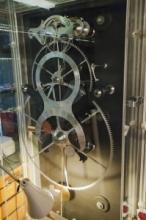Harrison decoded: towards a perfect pendulum clock
This post was written by Rory McEvoy
In July 2014 the NMM hosted on one-day conference, entitled Decoding Harrison, which presented the story of around forty years of collaborative research into John Harrison’s complex and surprising pendulum clock theory.
During the conference the exciting result of a previously unannounced and unofficial test of Martin Burgess’s ‘Clock B’ at the Royal Observatory was revealed.

‘Clock B’ is one of two clocks made from modern materials, chiefly duraluminium and invar, that follow the perceived format laid out in Harrison’s convoluted text: Concerning such mechanism… the lengthy title gives the reader an accurate sense of the complexity of the book itself.
For example, footnotes occasionally run across more than one page and if that was not enough, some even have their own footnotes. In short, it is not an easy read.
The unofficial test was conducted with the clock sealed into a Perspex case, which was made tamper-proof by applying two wax impressions, kindly provided by the Worshipful Company of Clockmakers and the National Physical Laboratory on 1 April, 2014, over wires threaded through the nuts and bolts that hold it shut.
On 6 January, 2015 – some 280 days after the case was sealed – Museum staff and the Master of the Worshipful Company of Clockmakers, Jonathan Betts, gathered to witness the going of the clock and initiate an official 100-day trial of its timekeeping.
Using the a radio-controlled clock that receives the MSF time signal, the accuracy of the speaking clock was confirmed and then used to determine to going of ‘Clock B’. We determined that the clock was showing UTC -1/4 second.
The clock will be observed throughout the trial using the above method as well as being continually monitored by a Microset and GPS as well as the environmental conditions inside the case (temperature, humidity and barometric pressure).
The trial is intended to prove that this clock is the most accurate mechanical clock with a pendulum swinging in free-air in existence. Throughout the trial I will be blogging and posting updated videos to youtube, which you can subscribe to.
To wrap up this exciting experiment we will be presenting the data collected, the current understanding of how the clock works and, indeed, why it works so well in a one-day conference at the National Maritime Museum on 18 April, 2015, which incidentally will mark the 3 year anniversary of Clock B’s stay here in Greenwich.
Details of the programme will be announced shortly.